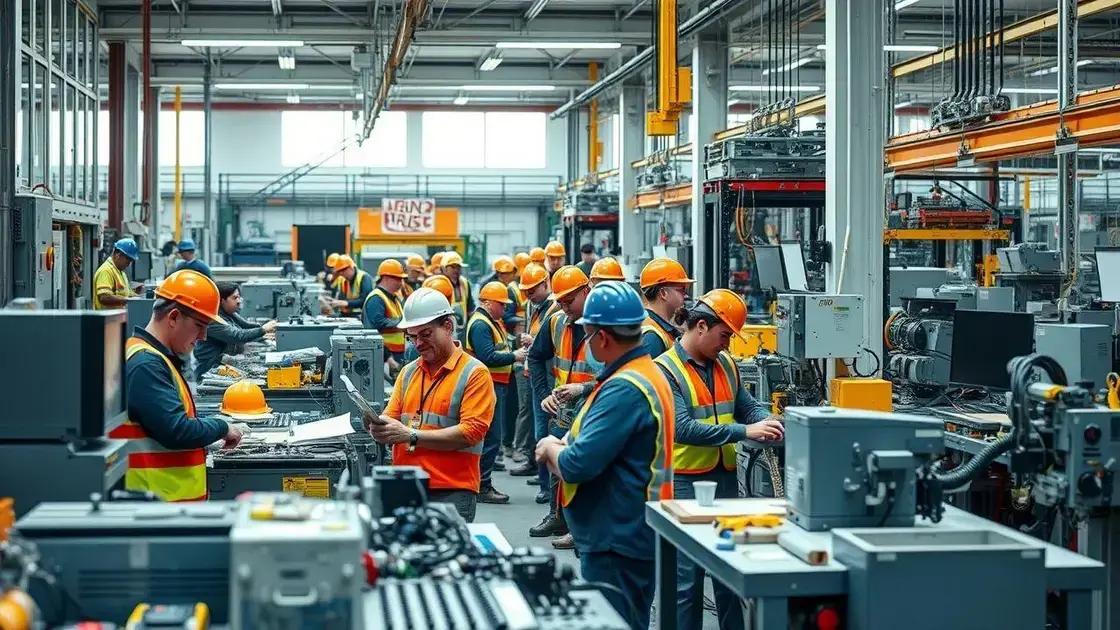Biden’s initiative to revitalize American manufacturing

Anúncios
Biden’s initiative to revitalize American manufacturing focuses on enhancing competitiveness, creating jobs, and promoting sustainability to strengthen the industry and boost the economy.
Biden’s initiative to revitalize American manufacturing is set to reshape the industrial landscape in the U.S. Have you ever wondered how this affects job creation and innovation? Let’s dive into the details.
Anúncios
Understanding Biden’s manufacturing initiative
Understanding Biden’s initiative to revitalize American manufacturing begins with recognizing its significance in shaping a robust economy. This initiative aims to create jobs, boost innovation, and enhance the competitiveness of U.S. manufacturing.
Key Components of the Initiative
At its core, the initiative focuses on several key components that are essential for revitalization:
Anúncios
- Investment in Technology: Modernizing facilities to incorporate advanced technologies.
- Workforce Development: Providing training and education for workers to meet the demands of the industry.
- Sustainable Practices: Encouraging environmentally friendly manufacturing processes.
This initiative not only addresses immediate employment needs but also positions the manufacturing sector for future challenges. With support from the government, businesses can explore new markets and innovate their production processes.
Impact on Job Creation
One significant aspect of the initiative is its potential to generate new jobs. By investing in local manufacturing, communities can see a rise in employment opportunities. The initiative emphasizes the need for a skilled workforce, indicating that training programs will be crucial in fostering talent.
Moreover, as companies adopt new technologies, they will require workers who are adept in these areas. With increased focus on workforce development, education institutions will likely align their programs with manufacturing needs. This ensures that the future workforce is equipped to succeed in a rapidly evolving landscape.
Collaborative Efforts
Collaboration is another vital element of Biden’s initiative. Partnerships between government, educational institutions, and private companies can create a synergistic effect. Through collaboration, resources can be pooled to maximize impact.
These partnerships may lead to innovative programs that enhance manufacturing capabilities and competitiveness. As different sectors come together, the potential for groundbreaking advancements in technology and practices expands.
In conclusion, understanding Biden’s manufacturing initiative reveals a comprehensive approach to revitalizing the sector. By focusing on key components like investment in technology, workforce development, and collaboration, the initiative sets the stage for a more sustainable and competitive future in American manufacturing.
Key goals of the revitalization plan
The key goals of Biden’s initiative to revitalize American manufacturing focus on creating a more competitive and sustainable industrial sector. These goals aim to address current challenges while preparing for future demands.
Enhancing Competitiveness
A primary goal is to enhance the competitiveness of U.S. manufacturing. To achieve this, the initiative emphasizes the need for innovation. Companies are encouraged to adopt new technologies that提升 operational efficiency and reduce costs.
- Investing in Modern Technologies: Integrating cutting-edge tools and machinery.
- Fostering Research and Development: Supporting new ideas and products to stay ahead.
- Promoting Industry Collaboration: Encouraging partnerships for shared success.
These strategies aim to help manufacturers not only survive but thrive in a global market. Furthermore, enhancing competitiveness contributes to job stability and creation.
Job Creation and Workforce Development
Another essential goal is to create high-quality jobs and foster workforce development. As the industry evolves, there is a clear need for skilled workers. The initiative supports various training programs to equip the workforce with necessary skills.
Efforts include:
- Providing Vocational Training: Focused programs in key manufacturing areas.
- Encouraging Apprenticeships: Hands-on experience for new workers.
- Partnering with Educational Institutions: Aligning curricula with industry needs.
By prioritizing job creation, the initiative aims to boost economic growth while ensuring that workers are prepared for the challenges ahead. It’s about not just filling jobs, but providing careers that can sustain families.
Promoting Sustainability
In addition, promoting sustainability stands out as a critical goal of the revitalization plan. The manufacturing sector is under increasing pressure to adopt environmentally friendly practices. The initiative encourages companies to innovate in ways that reduce their carbon footprint.
Key sustainable practices include:
- Implementing Cleaner Production Techniques: Using resources more efficiently.
- Investing in Renewable Energy: Utilizing solar and wind power in manufacturing.
- Reducing Waste: Adopting circular economy concepts.
Through these goals, the initiative seeks not only to strengthen the manufacturing sector but also to contribute positively to the environment. This alignment with sustainability trends is essential for long-term success.
Potential benefits for American workers

Potential benefits for American workers under Biden’s initiative to revitalize manufacturing are substantial. This initiative aims to create a better work environment and enhance job stability across the nation.
Increased Job Opportunities
One of the most significant benefits is the increase in job opportunities. By investing in manufacturing, the initiative encourages companies to hire more workers. This means more families will have access to stable jobs, which can lead to improved quality of life.
- Job Growth: More positions available in various manufacturing sectors.
- Higher Wages: Potential for better pay as demand for skilled workers rises.
- Career Advancement: Opportunities for training and promotions within the industry.
As the industry grows, workers may also benefit from enhanced job security. Employers are less likely to downsize in a thriving environment.
Workforce Development Programs
The initiative places a strong emphasis on workforce development. Through various programs, workers can receive training that aligns with industry needs. This prepares them for the future job market and equips them with new skills.
Training might include:
- Technical Skills: Learning how to operate advanced machinery.
- Soft Skills: Gaining communication and teamwork abilities for better workplace dynamics.
- Leadership Programs: Preparing workers for management roles.
Having access to such training programs ensures that workers are not just filling jobs but are prepared for long-term careers.
Support for Family and Community
In addition to job creation and skill development, the initiative supports families and communities. With more jobs available, local economies can flourish. When American workers earn more, they can invest back into their communities.
This supports various local services and initiatives, creating a ripple effect that benefits everyone. With stable employment, families can plan for the future and participate actively in their communities.
Challenges in the implementation
Challenges in the implementation of Biden’s initiative to revitalize American manufacturing can create obstacles that may delay progress. Understanding these challenges is crucial for effective planning and execution.
Funding and Budget Constraints
A key challenge is ensuring adequate funding for the initiative. Without proper financial support, many programs may struggle to take off. This can limit the scope of projects aimed at enhancing manufacturing capabilities.
- Inadequate Budgets: Limited resources can hinder technological upgrades.
- Long-term Financial Commitment: Sustaining investments over time is necessary for success.
- Dependence on Government Funding: Programs may rely heavily on public dollars, which can fluctuate.
These financial factors can affect everything from workforce development initiatives to infrastructure improvements, slowing down potential benefits.
Skilled Labor Shortages
Another significant challenge is the shortage of skilled labor. As industries adopt more advanced technologies, the demand for skilled workers increases. However, there may not be enough trained individuals to meet this need, which can impede progress.
Addressing this issue involves:
- Training Programs: Developing programs that target current skills gaps.
- Partnerships: Collaborating with educational institutions to align curricula with industry needs.
- Incentives: Offering incentives to attract talent into manufacturing fields.
Failure to adequately address these labor issues could limit the effectiveness of the revitalization efforts.
Resistance to Change
Resistance to change within organizations can also pose a challenge to the initiative. Some manufacturers may be hesitant to adopt new technologies or processes. This resistance can come from various factors, including a fear of disruption and the comfort of existing methods.
To overcome this, it is important to foster a culture of innovation. Encouraging a mindset that embraces change is essential for the initiative’s success. Effective communication about the benefits of new practices can help ease concerns.
The journey towards revitalizing American manufacturing is complex. By recognizing these challenges—funding constraints, labor shortages, and resistance to change—stakeholders can develop strategies to navigate them more effectively.
Future outlook for U.S. manufacturing
The future outlook for U.S. manufacturing appears promising as Biden’s initiative aims to create a more competitive and resilient industry. This revitalization plan focuses on not only recovering from current challenges but also positioning American manufacturing for long-term success.
Investment in Innovation
One key aspect of the future is the increased focus on investment in innovation. Manufacturers are expected to embrace advanced technologies to improve productivity and efficiency. These innovations will help businesses stay competitive in a global market.
- Automation: Incorporating robotics and AI to enhance production processes.
- 3D Printing: Utilizing additive manufacturing to reduce waste and streamline operations.
- Software Solutions: Implementing data analytics for smarter decision-making.
Such investments will not only boost productivity but also attract new talent to the industry, fostering a culture of continuous improvement.
Sustainability Trends
Another critical factor shaping the future of U.S. manufacturing is the increasing emphasis on sustainability. Companies are recognizing the need to adopt eco-friendly practices to meet consumer demand and regulatory requirements.
As part of this trend, manufacturers are likely to:
- Reduce Carbon Footprint: Implement strategies to minimize emissions in production.
- Utilize Renewable Energy: Shift towards solar and wind power solutions.
- Embrace Circular Economy Principles: Focus on recycling and waste reduction in processes.
These efforts will not only benefit the environment but also enhance brand loyalty among consumers who prioritize sustainability.
Global Market Dynamics
The future of U.S. manufacturing will also be influenced by global market dynamics. As supply chains become more complex, manufacturers must adapt to changes in international trade policies and economic conditions. Resilience will be key in navigating these challenges.
To maintain competitiveness on a global scale, manufacturers will need to:
- Diversify Supply Chains: Reduce dependency on single sources for materials.
- Invest in Local Production: Strengthen domestic manufacturing capabilities.
- Form Strategic Partnerships: Collaborate with global partners for shared success.
By taking proactive measures, U.S. manufacturers can better position themselves to thrive in an evolving economic landscape.
In conclusion, the revitalization of U.S. manufacturing represents a vital step toward a stronger, more sustainable economy. By focusing on innovation, job creation, and sustainable practices, the initiative aims to position American manufacturing for future success. While there are challenges to face, the potential benefits for workers and communities are significant. Embracing change and investing in the workforce will pave the way for a more resilient manufacturing sector.





